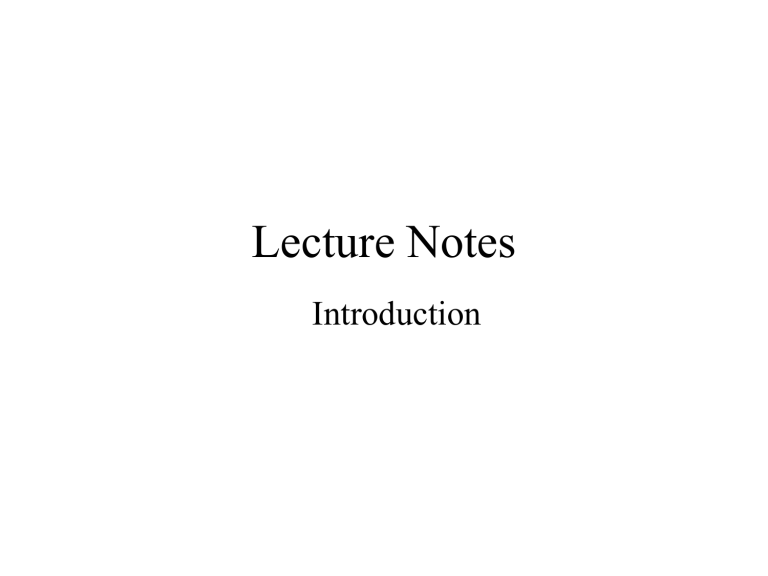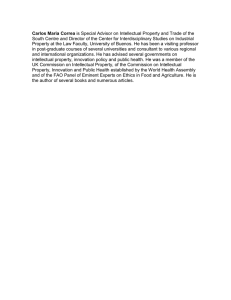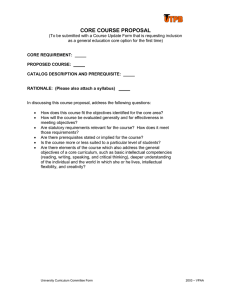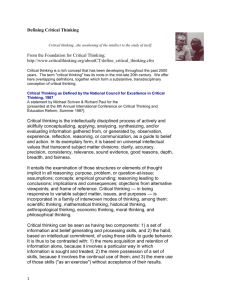
Lecture Notes Introduction Purpose • The purpose of this course is to develop thinking skills. We live in a society that mass produces information. Not all of it is true or well grounded in fact. The key challenge in an information age is to know how to judge the quality of the information, opinions, and arguments that we are exposed to on a daily basis. This includes the ideas, arguments and assertions that we see, hear or read in the news, in coursework, on the job and in all human relations. Critical thinking is a fundamental leadership competency. Critical Thinking Course Objectives • In this course students will learn how to: – critically read, listen, and write – separate bad information from good information – analyze arguments and construct cogent arguments – understand causal connections in systems – develop intellectual and personal discipline Critical Thinking Course Outline • Thinking About Thinking and Truth • Fallacious Thinking • Systems Thinking Critical Thinking Define Critical Thinking • Individually, use a short phrase to complete these sentences. Write down each response on a sticky note. • Critical thinking is ________________________. • Critical thinking is not _____________________. • Define Critical Thinking In groups of 5-6, debrief and try to come to a consensus. Write down each of your responses on two separate sheets of your flip chart. • Critical thinking is ________________________. • Critical thinking is not _____________________. What is Critical Thinking? “Higher-Order Thinking” “Complex Thinking” What is critical thinking? • Critical thinking – A set of conceptual tools used to make decisions • Intellectual skills and strategies • Reason-able process – A mental ability • Disciplined intelligence • Problem solving Critical Thinking Root words for critical thinking • krinein <Greek – Means decision-making • kritikos <Greek: krinein – Means discernment or the ability to judge • critical • criticism • critic • critique • Critical thinking is concerned with decisionmaking and the skills needed to make good decisions. Critical Thinking What is Critical Thinking? The words ‘critical’ and ‘criteria’ come from the same root word meaning judgment Critical Thinking is reasonable, reflective thinking that is focused on deciding what to believe or do. (Robert Ennis) Critical thinking = “Grappling with open-ended problems” • “Effective personal and professional functioning requires dealing with openended problems that are fraught with significant and enduring uncertainties about such issues as the scope of the problem, interpretations of relevant information, range of solution options, and potential outcomes of various options.” Examples of when we use critical thinking… • Professional problems - What is the best interpretation of a piece of literature? - How can a leader most efficiently promote effective team work? • Personal problems - What should I do to optimize my career development? • Civic problems - How should I vote on a particular ballot initiative? Benefits of critical thinking Critical thinking empowers and improves chances of success • in a career • as a consumer • in social roles in our community – personally, essential to personal autonomy – socially, essential to democratic system Critical Thinking Critical Thinking definition (From: Scriven and Paul, 2003) Critical thinking is the intellectually disciplined process that results in a guide to belief and action. Critical thinking is the intellectually disciplined process that results in a guide to belief and action. What are the “intellectual tools” that you use in your work? What does this “process” look like in field, in your discipline, in your division? What guides your beliefs and actions in the Division of Student Affairs? Critical Thinking definition (From: Scriven and Paul, 2003) Critical thinking is the intellectually disciplined process that results in a guide to belief and action. The tools for this “process” include actively and skillfully: conceptualizing applying analyzing synthesizing evaluating information gathered from, or generated by, observation experience reflection reasoning or communication Aspects of critical thinking • Issues – – – – factual interpretive evaluative mere verbal dispute • Claims – truth-statement with adequate support – assumption: claim without support • hidden assumptions undermine reliability of reasoning Invitation to Critical Thinking Chapter 1 Aspects of critical thinking • Issues – – – – factual interpretive evaluative mere verbal dispute • Claims – truth-statement with adequate support – assumption: claim without support • hidden assumptions undermine reliability of reasoning Critical Thinking Resolving obstacles to critical thinking Obstacle—relativism or subjectivism • Remedy—patience and tenacity in pursuit of the truth Obstacle—egocentrism and ethnocentricity • Remedy— intellectual humility Obstacle—intimidation by authority • Remedy—intellectual independence Obstacle—conformism • Remedy—intellectual courage Obstacle—unexamined and inferential assumptions, and presuppositions • Remedy—examination of assumptions What Critical Thinking is NOT • The problem of “egocentric” thinking: Leads to self-serving perspectives and evaluations Leads to a false sense of objectivity Leads to flawed thinking Lends itself to the unconscious substitution of subjective intuitions for intellectual standards in thinking Instead of: Its true because I believe it Its true because we believe it Its true because I want to believe it Its true because I have always believed it Its true because its in my selfish interest to believe …we want to foster an awareness that critical thinking is more than thinking, it’s: Reflecting upon Questioning Monitoring • …my very reasoning itself in order to continuously improve my thinking. • It’s “thinking things through.” What does a critical thinker do? A critical thinker • looks more deeply into – sources of our information – assumptions underlying our beliefs • determines what is at issue • uses discipline • uses creativity Critical Thinking What does a critical thinker do? A critical thinker • pursues truth • employs intellectual virtues – patience – tenacity – humility – courage – tolerance – respect Critical Thinking A Well-Cultivated Critical Thinker: Raises vital questions and problems, formulating them clearly and precisely Gathers and assesses relevant information, using abstract ideas to interpret it effectively Comes to well-reasoned conclusions and solutions, testing them against relevant criteria and standards Thinks open mindedly within alternative systems of thought, recognizing and assessing, as needs be, their assumptions, implications, and practical consequences Communicates effectively with others in figuring out solutions to complex problems What you can do: 1. Become aware and discuss with your colleagues how and why critical thinking is important to your work. 2. Model for students—in a very explicit way—how you “think things through.” Give the gift of your time, your mentorship in issues large and small. 3. Remember that students are on a developmental path. Meet them where they are in terms of their readiness for complex decision making. Sometimes the comfort zone is for absolute “rights and wrongs.” 4. Never forget that at the heart of critical thinking is learning to ask relevant, important questions. To re-evaluate, to reconsider and reflect on the answers –and then ask the next set of questions—are the intellectual habits of mind we wish to cultivate in our students. Critical Thinking Critical Thinking Critical Thinking




